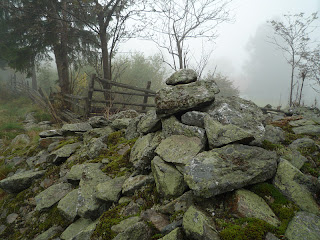http://en.wikipedia.org/wiki/Dry_stone:
"Dry stone is a building method by which structures are constructed from stones without any mortar to bind them together. Dry stone structures are stable because of their unique construction method, which is characterized by the presence of a load-bearing facade of carefully-selected interlocking stones. Dry-stone technology is best known as retaining wall construction, but dry stone fences, buildings, bridges, and other structures also exist."
"Location and terminology
Terminology varies regionally. When used as field boundaries, dry stone structures often are known as dykes, particularly in Scotland. Dry stone walls are characteristic of upland areas of Britain and Ireland where rock outcrops naturally or large stones exist in quantity in the soil. They are especially abundant in the West of Ireland, particularly Connemara. They also may be found throughout the Mediterranean, as in Majorca, Catalonia, Languedoc, Provence, Liguria, the Apulia region of Italy, Cyprus, and in the Canary Islands, including retaining walls used for terracing. Such constructions are common where large stones are plentiful (for example, in The Burren) or conditions are too harsh for hedges capable of retaining livestock to be grown as reliable field boundaries. Many thousands of miles of such walls exist, most of them centuries old.
In the United States they are common in areas with rocky soils, such as New England, New York, New Jersey, and Pennsylvania and are a notable characteristic of the bluegrass region of central Kentucky, where they are usually referred to as rock fences, and the Napa Valley in north central California. The technique of construction was brought to America primarily by Scots-Irish immigrants. The technique was also taken to Australia (principally western Victoria and some parts of Tasmania and New South Wales) and New Zealand (especially Otago)."
"Similar walls also are found in the Swiss-Italian border region, where they are often used to enclose the open space under large natural boulders or outcrops.
The higher-lying rock-rich fields and pastures in Bohemia's South-Western border range of Šumava (e.g. around the mountain river of Vydra) are often lined by dry stone walls built of field-stones removed from the arable or cultural land, serving both as cattle/sheep fences and the lot's borders; sometimes also the dry stone terracing is apparent, often combined with parts of stone masonry (house foundations and shed walls) held together by a clay-cum-needles "composite" mortar.
Dry stone wall construction was known to Bantu tribes in southeastern Africa as early at 1350 to 1500 AD. When some of the Zulu migrated west into the Waterberg region of present day South Africa, they imparted their building skills to Iron Age Bantu peoples who used dry stone walls to improve their fortifications.
In Peru in the 15th century AD, the Inca made use of otherwise unusable slopes by building dry stone walls to create terraces. They also employed this mode of construction for free-standing walls. Their ashlar type construction in Machu Picchu uses the classic Inca architectural style of polished dry-stone walls of regular shape. The Incas were masters of this technique, in which blocks of stone are cut to fit together tightly without mortar. Many junctions are so perfect that not even a knife fits between the stones. The structures have persisted in the high earthquake region because of the flexibility of the walls and that in their double wall architecture, the two portions of the walls incline into each other."
etc.

















































